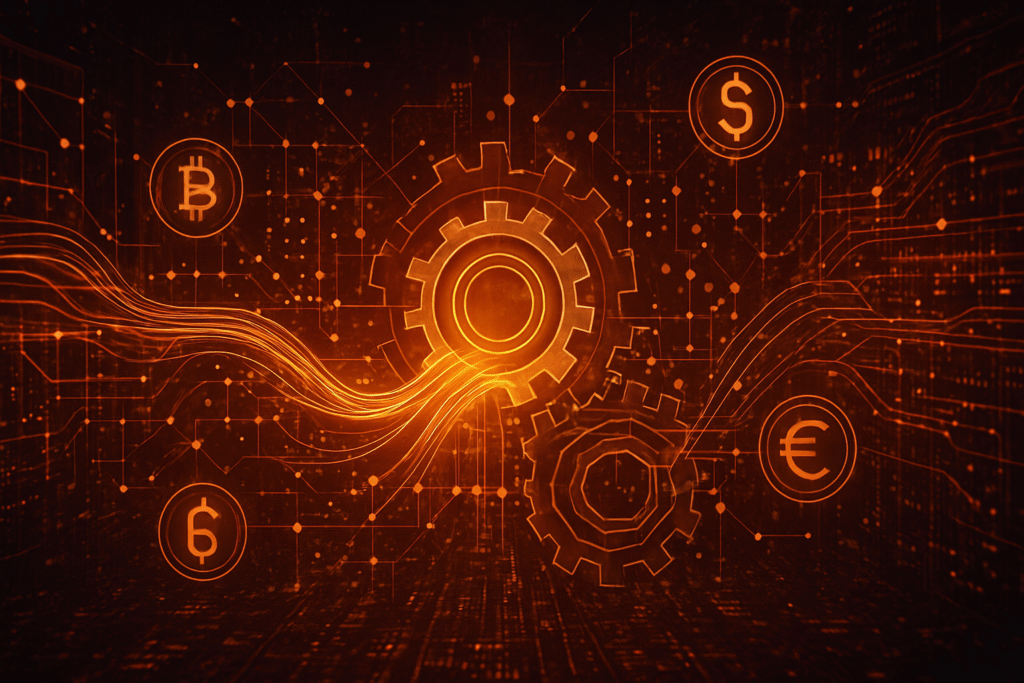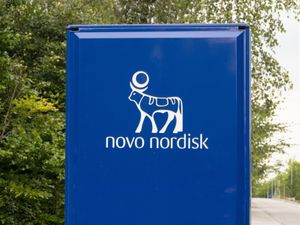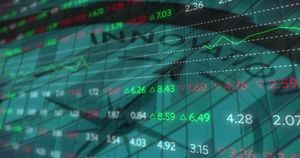
In a landmark development signaling a significant leap in institutional adoption of blockchain technology, the high-performance Sei blockchain, in conjunction with the innovative KAIO protocol, has announced the successful launch of Hamilton Lane's (NASDAQ: HLNE) tokenized feeder for its Senior Credit Opportunities Fund (SCOPE) today, October 15, 2025. This pivotal event follows a series of strategic expansions by KAIO throughout 2025, including its rebranding from Libre Capital on July 30, 2025, and the subsequent tokenization of major funds from financial giants like BlackRock and Brevan Howard. These initiatives solidify KAIO's position as a leading platform for bringing real-world assets (RWAs) on-chain.
The immediate market reaction, while complex for specific token prices, underscores a growing confidence in purpose-built blockchain infrastructure and compliant tokenization solutions. This collaboration between Sei's ultra-fast, trading-optimized Layer 1 and KAIO's institutional-grade RWA framework represents a powerful convergence, poised to unlock unprecedented liquidity and accessibility for traditional financial products within the decentralized finance (DeFi) ecosystem. The implications extend far beyond a single fund launch, highlighting a maturing crypto landscape where traditional finance is not just observing, but actively integrating with, cutting-edge Web3 innovations.
Market Impact and Price Action
The series of announcements from KAIO, particularly the tokenization of funds from BlackRock (NYSE: BLK), Brevan Howard, and Hamilton Lane (NASDAQ: HLNE) on the Sei Network, generated an initial wave of bullish sentiment around the $SEI token. Following the BlackRock and Brevan Howard launches around October 8-10, 2025, $SEI showed "fresh signs of life," experiencing a modest 2.4% increase within 24 hours. Analysts, buoyed by the prospect of significant institutional inflows, made bullish projections, with some anticipating a breakout towards $0.36–$0.50 and even more ambitious targets of $2 in a broader bull run.
However, despite this overwhelmingly positive news regarding institutional adoption, the $SEI token has experienced considerable downward pressure in the broader market. As of October 15, 2025, $SEI's price had declined by 21% over the past week and a more significant 32% over the past month. On the day of the Hamilton Lane announcement, $SEI fluctuated between approximately $0.2156 and $0.23, exhibiting mixed daily performance that contributed to the overall weekly and monthly downturn. A scheduled token unlock on October 15, releasing 1.15% of $SEI's supply (valued at $15.77 million), was identified as a contributing factor to this selling pressure, exacerbated by prevailing bearish market conditions.
Despite the challenging price action for the $SEI token, the underlying Sei Network has demonstrated robust growth in activity. Daily transactions now exceed 1.6 million, with over 600,000 active wallets, much of which is attributed to institutional flows and DeFi deployments. Sei's Total Value Locked (TVL) has climbed past $530 million, marking one of the fastest growth streaks for a Layer 1 blockchain this year. Trading volume for $SEI on October 15 ranged from approximately $156 million to $180 million, with derivative market open interest showing a slight increase, indicating sustained, albeit cautious, engagement. It is crucial to note that the KAIO protocol, which facilitates the tokenization of institutional RWAs, does not currently have a publicly traded token available to retail investors; its tokenized funds are exclusively for institutional and accredited investors. This distinction is vital to avoid confusion with other cryptocurrencies that may share similar names.
Community and Ecosystem Response
The social media sentiment and broader crypto community discussions surrounding institutional Real-World Asset (RWA) tokenization, Sei blockchain's pivotal role, and the KAIO protocol's recent activities are overwhelmingly positive. Industry thought leaders and crypto influencers widely regard RWA tokenization as a major growth driver for the crypto space in 2024 and 2025, welcoming the potential for increased adoption and innovation that institutional capital brings to the blockchain ecosystem.
Key themes dominating the discussion include the promise of enhanced liquidity and accessibility through fractional ownership, the increased transparency and security offered by blockchain's immutable nature, and the operational efficiencies gained through automated settlements and reduced administrative burdens. Most importantly, the tokenization of RWAs is seen as a crucial step in blurring the lines between traditional finance (TradFi) and decentralized finance (DeFi), fostering a more integrated and inclusive financial ecosystem. The growing regulatory support and clearer guidelines, exemplified by the U.S. Treasury's acknowledgment of tokenization's liquidity-enhancing potential, further bolster institutional confidence. While the outlook is largely optimistic, some discussions acknowledge challenges such as navigating complex regulatory landscapes and the need for investor education, alongside debates about potential centralization with increased institutional involvement.
Sei is strategically positioning itself as a core infrastructure layer for RWA markets, specifically designed to meet the rigorous demands of institutional-grade asset trading. Its architecture, highlighted for its high transaction throughput, efficient Twin-Turbo Consensus, sub-second finality (under 400ms), and chain-level compliance features, provides the necessary scalability and security for handling tokenized real-world assets. The network's ability to process 12.5k transactions per second, with projected 5 gigagas per second throughput with its Autobahn consensus, positions it to match or exceed traditional Web2 financial systems, making it ideally suited for the expanding tokenized treasury market.
KAIO protocol, acting as the on-chain infrastructure platform for regulated RWAs, is at the forefront of tokenizing major institutional funds. Its recent activities have generated significant buzz: the launch of tokenized shares of BlackRock's (NYSE: BLK) ICS US Dollar Liquidity Fund and Brevan Howard's Master Fund on the Sei Network, followed by today's Hamilton Lane (NASDAQ: HLNE) Senior Credit Opportunities Fund (SCOPE) tokenization. These launches have prompted enthusiastic reactions from crypto influencers, with many exclaiming, "WALL STREET JUST MET WEB3 ON SEI! BlackRock and Brevan Howard have launched tokenized funds on $SEI using KAIO's advanced RWA infrastructure. This is the bridge between traditional finance and DeFi being built in real time. $SEI is no longer 'potential' it's the core layer for institutional tokenization." These developments are seen as pivotal moments accelerating the convergence of traditional finance with Web3, driving liquidity, accessibility, and new use cases within the DeFi ecosystem.
The effects on related DeFi and Web3 applications are perceived as profound. Institutional involvement is expected to inject substantial liquidity into Bitcoin DeFi (BTCFi) and the broader DeFi landscape, bridging the gap between TradFi and DeFi with compliant, auditable, and transparent on-chain products. This will unlock new use cases, allowing tokenized RWAs to serve as collateral within DeFi protocols or be integrated into stablecoin frameworks. The market for tokenized assets is projected to reach $16 trillion by 2030, with some estimates even higher, underscoring the potential for mainstream adoption and capital market modernization. Ethereum (ETH) is also expected to benefit significantly due to its robust smart contract ecosystem, accounting for 50% of the RWA tokenization market by Q3 2025.
What's Next for Crypto
The integration of institutional Real-World Asset (RWA) tokenization, facilitated by high-performance blockchains like Sei and platforms such as KAIO, is poised to bring profound short-term and long-term implications for the crypto market. This convergence of traditional finance and decentralized finance is driven by a quest for enhanced liquidity, efficiency, transparency, and broader access to assets, fundamentally reshaping the global financial system.
In the short term, we anticipate increased capital inflows into the crypto ecosystem as institutional investment products become directly available on-chain. This will enhance the credibility of the blockchain space, attracting further institutional and potentially retail interest. The composability offered by platforms like KAIO on Sei will foster the creation of novel financial products and strategies, as tokenized RWAs can be integrated into DeFi applications as collateral or yield-bearing reserves. This could generate a positive "halo effect" on broader crypto assets, potentially driving price appreciation and renewed investor confidence. However, the immediate impact may remain somewhat concentrated on institutional and accredited investors, leading to a nuanced community response compared to retail-centric crypto launches.
Looking further ahead, the long-term implications are transformative. RWA tokenization is building an indispensable bridge between TradFi and DeFi, leading to a more integrated, efficient, and transparent global financial system. This movement promises the democratization of investment access through fractional ownership of high-value assets, potentially unlocking trillions of dollars in previously illiquid capital. Blockchain technology is increasingly becoming a core infrastructure layer for global finance, supporting real-time, programmable capital markets. The RWA market is projected for explosive growth, with estimates ranging from $4 trillion to $30 trillion by 2030, encompassing various asset classes from government bonds to real estate.
Potential catalysts and developments to watch include continued improvements in regulatory clarity and harmonization across jurisdictions, which will de-risk institutional participation. Technological advancements in blockchain scalability, interoperability, and security, alongside successful case studies and high-profile institutional partnerships like those seen with KAIO, will build further confidence. Increasing institutional demand for yield, diversification, and efficiency will also drive adoption, particularly in areas like private credit and tokenized government securities.
For crypto projects, strategic considerations include prioritizing compliance and regulation, developing real-world utility, enhancing scalability and security, and building interoperable bridges between TradFi and DeFi. For crypto investors, it will be crucial to diversify portfolios across major cryptocurrencies and promising RWA projects, monitor the evolving regulatory landscape, and assess projects that align with institutional interests. Prudent risk management remains essential due to potential volatility and smart contract vulnerabilities. The most likely scenario is a gradual, steady integration, with a continuous blurring of lines between TradFi and DeFi, though accelerated integration could occur with significant regulatory clarity.
Bottom Line
The recent advancements by the Sei blockchain and KAIO protocol, culminating in today's Hamilton Lane fund launch, mark a pivotal moment in the institutional adoption of blockchain technology. These innovations are not merely incremental; they represent a fundamental shift in how traditional finance interacts with the decentralized world. Sei's purpose-built, high-performance Layer 1 infrastructure, combined with KAIO's compliant and robust RWA tokenization platform, is effectively bridging the chasm between TradFi and Web3.
The long-term significance of these developments cannot be overstated. By bringing institutional-grade assets like money market funds and private credit on-chain, Sei and KAIO are unlocking trillions of dollars in previously illiquid capital, democratizing investment access, and paving the way for a more efficient, transparent, and globally integrated financial system. This trajectory suggests that blockchain will become an indispensable core infrastructure for global finance, supporting real-time, programmable capital markets.
For crypto investors and enthusiasts, the key takeaway is the accelerating convergence of traditional and digital asset markets. While the $SEI token has experienced recent price headwinds due to broader market conditions and token unlocks, the underlying network activity and institutional adoption narrative remain exceptionally strong. It underscores the importance of differentiating between short-term price fluctuations and long-term fundamental growth driven by real-world utility. Important metrics to monitor include the continued growth of the RWA market size, institutional capital inflows into tokenized assets, further regulatory clarity, and the ongoing development and adoption metrics of the Sei network. This era promises unprecedented opportunities for those who understand and adapt to the evolving landscape where Wall Street truly meets Web3.
This article is for informational purposes only and does not constitute financial or investment advice. Cryptocurrency investments carry significant risk.





